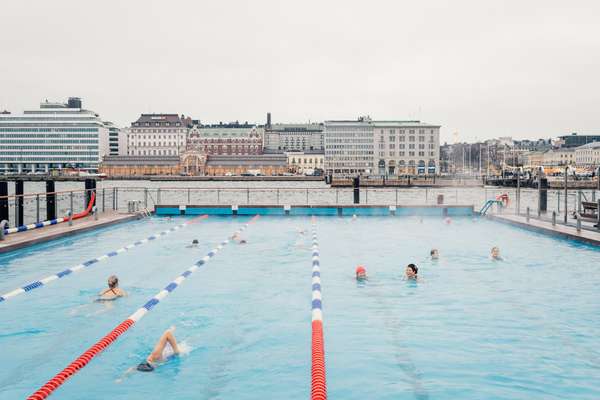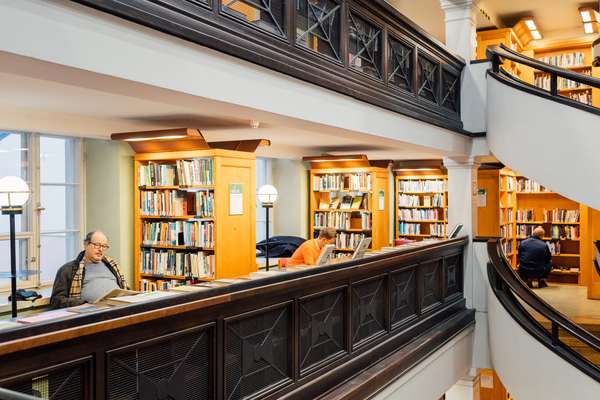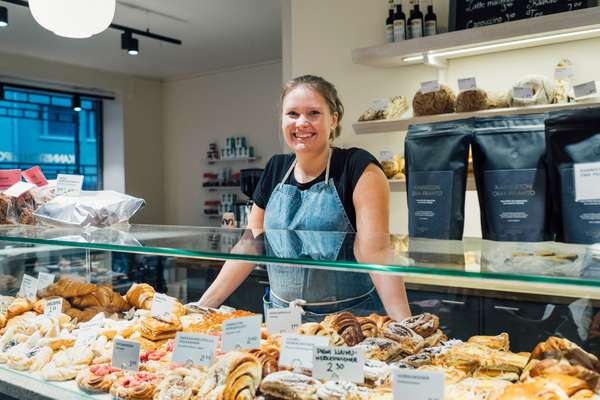Global Affairs. / Finland
Happiness lab
According to the UN, Finns live in the world’s happiest nation – which is news to many of them. Look a little deeper though and it’s clear that decades of government-led tweaks to Finnish life have conjured up a surprising level of contentment.
If there’s one saying that tidily sums up the Finnish national culture, it’s perhaps this: Kell’ onni on se onnen kätkeköön – or “He who has happiness should hide it.” The adage points to the Finns’ steadfast avoidance of boasting or even admitting to being more comfortable than a neighbour. In other words, even when they’re happy Finns won’t show it.
So it was with much astonishment, both in the country and abroad, that Finland came in at number one in the UN’s 2018 World Happiness Report, a global ranking based on research by Gallup World Poll. While many column inches in the Finnish press were devoted to denouncing the methodology of the report (a legitimate gripe, to be fair), the coverage in the international press could be boiled down to one word: “Huh?”
Yet Finland has long been dedicated to improving the wellbeing of its citizens. Like other Nordic countries it has a robust welfare system that champions both financial and social equality. But Finland is unique in that it has, for many years, operated almost as if the entire country was a wellbeing laboratory and its citizens lab rats. In this lab the state has played the role of scientist, intent on improving the comfort and security of the nation’s five million residents through thorough research and a near constant series of experiments covering health, education, employment and more.
“One often forgets that Finland was one of the poorest countries in Europe,” says Juha Leppänen, chief executive of Demos Helsinki, a think-tank that focuses on building a sustainable and fair society. “So the only way for a country like this – very remote, with horrible weather conditions – to be successful was to focus on its people.”
By many definitions, Finland has achieved success as a nation: it is among the wealthiest countries in the world by GDP per capita; the maternal mortality rate is one of the lowest on the planet; and the poverty rate is low, as is the crime rate. So what is there left to do but pursue – and perhaps even perfect – happiness?
Happiness in Finland begins in the womb. In central Helsinki’s Töölö district, Richard and Karla Jerome are sitting in a room at a neuvola, a child-health clinic, as a nurse observes their boisterous toddler Arthur. The nurse asks Karla, a blonde Finn who grew up in the country, and Richard, who moved from India to work for Nokia and has since become a citizen, about Arthur’s sleeping habits and motor skills while the little boy scoots around the floor with toys. “He’s almost walking on his own,” says Richard proudly. Karla has been coming to this clinic since she became pregnant with Arthur (and, before that, with his older brother Aaron). Even before he was born, Arthur’s health has been tracked and documented in a database under his personal identity code, an ID number given to each Finn by the government and which is associated with everything from their medical records to their tax history.










Today, on his first birthday, Arthur is weighed, measured and vaccinated against polio, pneumonia, diphtheria and a range of other ailments. The appointment goes as well as any check-up involving a shot and a one-year-old can (though tears are surprisingly minimal) and once the needles have been administrated and Arthur’s growth has been calculated, the nurse diligently inputs the new information into the database.
But Arthur’s medical information isn’t being recorded simply for his own personal records (though he will have access to this information for the rest of his life). Beginning in the 1960s, the state began tracking the health of each of its citizens from birth until death using their personal identity code, recording every hospitalisation, outpatient treatment and prescription and analysing the data. (Healthcare is managed at a municipal level in Finland but the state has been working to centralise the data collected on each citizen at a national level.)
“We use this data to monitor the population’s health – how many people have diabetes or how many people are dying from cardiovascular disease,” says Markku Peltonen, head of unit at the National Institute for Health and Welfare. “Slowly but surely, each healthcare organisation will be a part of this.” The state-funded research institute analyses Finns’ medical data and then formulates policy recommendations based on its findings. Because the population of the country is small, the institute is often able to spot patterns. When an uptick in diabetes was observed, the institute was able to recommend changes to the national nutritional guidelines. “We have the advantage here that we are a small country,” adds Peltonen.
At the municipal level, this type of close monitoring can be especially nimble. Taru Koivisto, director for the department for wellbeing and services in the Ministry of Social Affairs and Health, says that by tracking each of its citizens the municipality can best learn where to apply its resources in order to improve wellbeing. “Municipalities take this responsibility seriously,” she says. “It creates a sense of security for people – if they need something they’ll get it.” She gives a small but striking example, which occurred when one municipality saw an increase in people from a certain neighbourhood being hospitalised with broken hips. Having studied the data, authorities then understood that they needed to apply more sand to the icy pavements in the area to prevent falls on the slippery streets.
Though there is something of an Orwellian note to the level at which the state monitors its citizens, Finns don’t seem all that bothered by it. Everyone we speak to notes how much faith they have in their government institutions. “People trust us,” says Peltonen of the National Institute for Health and Welfare. “We really want to keep it that way. We couldn’t handle a breach of trust.”
And it’s not just in healthcare that the state has a heavy influence. In many ways, education has been the most successful Finnish experiment of all. For decades the country has offered universal basic education to all children and adolescents, with a focus on small class sizes. The result is that more than 70 per cent of Finns pursue higher education (versus 49 per cent of pupils in England).
On a dreary November morning we visit Saunalahti, a school in Espoo, where hundreds of small, shoeless Finns buzz through the halls. The award-winning building, which opened in 2012, was designed to foster the flexible approach to learning that the school is pioneering (educators worked with Verstas Architects on the school’s layout). The school and its curriculum are built around the goal of having kids learn outside of the classroom. Around every corner is a space for children to work independently or in small groups, whether it’s a cosy nook around a brick fireplace or comfortable seating areas overlooking the busy dining hall. They are given plenty of freedom to roam the school, working anywhere they like, and each child is given a customised lesson plan that is tailored to his or her needs. “Children are individuals,” says Hanna Sarakorpi, Saunalahti’s principal, speaking from her second-floor office.
This approach to freedom and learning is something that has been developed over the past decade; Sarakorpi had a hand in planning the government’s new national curriculum, which embodies the practices she has embraced here at Saunalahti. The school also trials smaller experiments when it comes to learning: a recent example was a test run to incorporate more storytelling in maths lessons for younger pupils. Sarakorpi describes the school’s approach as a “holistic” one that is not just interested in test scores but also on helping children to fully develop. “Based on my years of experience, this system has improved their wellbeing.”
The state wants to get even more serious about the role of experimentation in society. The current government has embraced the idea with such zeal that it has formalised the process. Experimental Finland is a project launched by the government in 2016 with a budget of €3m. It has embarked on a series of experiments, some conducted independently and others in conjunction with private firms, NGOs or regional groups. The experiments all fall under the umbrella of three themes – the circular economy, artificial intelligence and employment – but, according to Markus Kanerva, a senior specialist on the project, the larger aim is “to improve society by gaining knowledge”.
Experiments have ranged as widely as an electric car-sharing pilot in the city of Lappeenranta, in Finland’s southeast, to free pre-school education for children under five in the municipality of Liperi. Virve Hokkanen, project manager of Experimental Finland, notes that there has been “a lot of jealousy” from other nations. “Not every country can do it,” she says.
But not all ideas prove successful. The basic-income experiment – by which 2,000 randomly selected unemployed Finns receive €560 a month for two years – has been criticised by everyone from the international press to the experts who designed the study. The pilot runs until the end of 2018 and is intended to determine whether such financial support could encourage people to get back into work. “The tricky part is that this is messy,” says Johanna Kotipelto, another senior specialist with Experimental Finland.
Yet all this experimentation – and monitoring and research – means that Finland has, for quite some time now, been fine-tuning its society. It has had a knock-on effect on health, education and employment – and yes, even happiness. It’s not just the fact that the state plays such an active role in its citizens’ lives that contributes to the nation’s wellbeing but the idea that Finns, by and large, feel secure as a result.
Most Finns don’t see the state’s work as an infringement on their freedom but an advancement of it. “It is obviously a good thing to allow people to make bad choices,” says Frank Martela, a Finnish academic who specialises in the psychology and philosophy of wellbeing. “But I think it is a good thing for the state to take responsibility for citizens with a security net.” If the fundamental basics needed for a good life are looked after by the state, goes the thinking, then the average citizen is free to focus on their own pursuits, whatever they may be: time spent with family, work that offers a sense of purpose or the security to try new things.
Perhaps part of the reason why Finns have such a hard time believing in their own happiness is that there are two words for “happy” in the Finnish language. Iloinen is one, which roughly translates into the idea of happiness as being cheerful or joyous – a tricky feeling for anyone to sustain day in, day out. But then there is also onnellinen, which connotes not a spring in your step but a feeling of being fortunate and content with one’s life. In that sense, Finns have every reason to be the happiest people in the world – whether or not they are willing to show it.


